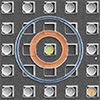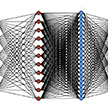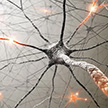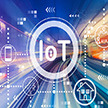Showing Spotlights 33 - 40 of 213 in category All (newest first):
 Researchers have created the first-ever 16x16 array of ionic transistors that operate in an aqueous electrolytic solution. This demonstrates the potential of aqueous ionics to enable new low-power, bio-inspired computing modalities.
Researchers have created the first-ever 16x16 array of ionic transistors that operate in an aqueous electrolytic solution. This demonstrates the potential of aqueous ionics to enable new low-power, bio-inspired computing modalities.
Sep 15th, 2023
 Researchers have developed efficient terahertz radiation sources by exploiting the innate layered anisotropy of conductive metal oxides, enabling new capabilities for integrated terahertz technologies.
Researchers have developed efficient terahertz radiation sources by exploiting the innate layered anisotropy of conductive metal oxides, enabling new capabilities for integrated terahertz technologies.
Sep 13th, 2023
 Discover the nanoscale science behind nature's vivid structural colors. This article unravels how nanostructures like photonic crystals manipulate light without pigments to generate colors in organisms. Learn how researchers apply these bioinspired designs to develop advanced optical technologies.
Discover the nanoscale science behind nature's vivid structural colors. This article unravels how nanostructures like photonic crystals manipulate light without pigments to generate colors in organisms. Learn how researchers apply these bioinspired designs to develop advanced optical technologies.
Aug 8th, 2023
 Discover how machine learning and data-driven approaches are revolutionizing the design of soft materials like polymers and rubbers, making them more efficient and adaptable to various applications.
Discover how machine learning and data-driven approaches are revolutionizing the design of soft materials like polymers and rubbers, making them more efficient and adaptable to various applications.
May 23rd, 2023
 Innovative study replicates human fingerprint patterns and sweating in artificial materials, offering groundbreaking advancements in soft robotics, biometrics, and biomimetic technology
Innovative study replicates human fingerprint patterns and sweating in artificial materials, offering groundbreaking advancements in soft robotics, biometrics, and biomimetic technology
May 11th, 2023
 Perovskite solar cells (PSCs) are complex devices made up of multiple materials that have many different factors affecting their properties, which makes it difficult to analyze them comprehensively. Machine Learning (ML) can efficiently handle these complexities and help scientists in the design of new PSCs. We outline the current state and future prospects of ML in perovskite solar cell research, including data sources, feature extraction, algorithms, model validation, interpretation, and challenges.
Perovskite solar cells (PSCs) are complex devices made up of multiple materials that have many different factors affecting their properties, which makes it difficult to analyze them comprehensively. Machine Learning (ML) can efficiently handle these complexities and help scientists in the design of new PSCs. We outline the current state and future prospects of ML in perovskite solar cell research, including data sources, feature extraction, algorithms, model validation, interpretation, and challenges.
Feb 27th, 2023
 Neuromorphic engineering is focused on developing computer hardware and software systems that mimic the structure, function, and behavior of the human brain. The goal of neuromorphic engineering is to create computing systems that are much more energy-efficient, scalable, and adaptive than conventional computer systems, and that can solve complex problems in a manner that is similar to how the brain solves problems. Neuromorphic computing is a specific application of neuromorphic engineering. It involves the use of hardware and software systems that are designed to process information in a manner that is similar to how the human brain processes information.
Neuromorphic engineering is focused on developing computer hardware and software systems that mimic the structure, function, and behavior of the human brain. The goal of neuromorphic engineering is to create computing systems that are much more energy-efficient, scalable, and adaptive than conventional computer systems, and that can solve complex problems in a manner that is similar to how the brain solves problems. Neuromorphic computing is a specific application of neuromorphic engineering. It involves the use of hardware and software systems that are designed to process information in a manner that is similar to how the human brain processes information.
Feb 13th, 2023
 Key components that are essential to the functioning of the Internet of Things include sensors and devices, network connectivity, data storage and processing, user interfaces, and security. Many aspects of these elements can be enhanced by nanotechnologies. Nanotechnology can enhance the performance and capabilities of IoT devices by enabling the creation of smaller, more efficient, and more versatile sensors, antennas, and processors. These improvements can lead to greater accuracy, energy efficiency, and versatility in a variety of applications, including healthcare, industrial monitoring, and environmental sensing.
Key components that are essential to the functioning of the Internet of Things include sensors and devices, network connectivity, data storage and processing, user interfaces, and security. Many aspects of these elements can be enhanced by nanotechnologies. Nanotechnology can enhance the performance and capabilities of IoT devices by enabling the creation of smaller, more efficient, and more versatile sensors, antennas, and processors. These improvements can lead to greater accuracy, energy efficiency, and versatility in a variety of applications, including healthcare, industrial monitoring, and environmental sensing.
Jan 9th, 2023
 Researchers have created the first-ever 16x16 array of ionic transistors that operate in an aqueous electrolytic solution. This demonstrates the potential of aqueous ionics to enable new low-power, bio-inspired computing modalities.
Researchers have created the first-ever 16x16 array of ionic transistors that operate in an aqueous electrolytic solution. This demonstrates the potential of aqueous ionics to enable new low-power, bio-inspired computing modalities.
 Subscribe to our Nanotechnology Spotlight feed
Subscribe to our Nanotechnology Spotlight feed





